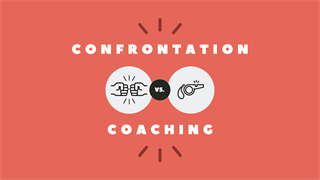
In a recent training, a leader made the comment that the coaching process we were learning was just a way "to confront softer." This was a great opportunity to clarify the difference between confrontation and coaching.
Characteristics of Confrontation
When we confront someone, we usually come preloaded with judgment about being in the right and armed for battle to prove it. There's going to be a winner and a loser in this interaction.
Confrontation inevitably attracts a fight or flight response in others. They will do whatever they can to either win or get out of the situation offering mindless compliance and agreement.
We often let winning become more important than the relationship, a successful outcome or our own integrity. We work up our courage and march into battle with righteous anger (or at least irritation) at our side.
This is often a high stress, high volume activity where our mouths work faster than our brains. And it hurts – people, processes and productivity.
Hostility ≠ Accountability
This is a good way to prepare for a fight but not for a problem-solving coaching session that should support a positive change. Although we often confuse the two, giving up hostility does not mean giving up accountability.
How To Approach Coaching Your Employees
Quality work is the result of a set-up for success and the maintenance of positive workplace relationships. We must adopt the mindset of viewing our employees as partners in problem-solving conversations.
This is true even if the problem appears to be the employee’s.
In every performance issue, there are variables whose impact must be explored in a problem-solving discussion. Our willingness to track down the root cause is important if we are going to resolve the problem and keep relationships strong.
Give Up Your Assumptions
We begin with the mindset that we don't know why the performance gap occurred, only that it did. Assuming nothing, we approach the conversation with openness and curiosity. Both are necessary for a true exploration of the root cause of the problem – not just its symptoms or judgments about the person. We explore root cause to ensure that a set up for success existed.
Ask yourself the following:
- Did we fulfill our role by communicating expectations and providing feedback along the way?
- Did we remove obstacles and coach the employee through challenges?
- Did the company fulfill its role by providing training, resources, and clear procedures?
- Did the employee fulfill his role by using the set up for success to create value, address challenges or alert leaders when challenges move beyond them?
Create a Feeling of Safety
We must support a feeling of safety in this exploration, or we will attract defensiveness rather than transparency. An employee who feels safe with us will be more inclined to provide the information we need.
Our words and tone must reflect our openness and curiosity to both resolve the problem and preserve the quality of the relationship.
Finally, don’t let your upset become the consequence for failure. Don’t distract your employee from their own disappointment about their performance by broadcasting yours.
Remember, you are a team and your success comes through theirs. A positive relationship sustained even when there are difficulties, will always pay dividends.
Application:
- The next time you feel the need to confront someone and have the correlating emotional symptoms of outrage or anger, take a breath. Give yourself a minute. Think of the most desirable outcome you want – long term. After all, you'll need to work with this person again.
- Ask yourself if the confrontation you are moving towards could possibly bring about that result.
- Begin with the end in mind and prepare a script that will more likely achieve this desired end. We’ve discussed coaching models previously that will help with this.
- Before you hold this conversation make sure you are in a good place to have it. Ensure you have cleared the upset, hurt or anger and are no longer in fight or flight yourself.
When we exchange our irritation and the “right to strike” for a safe discussion that solves the problem and preserves the relationship, we support our effectiveness and leadership credibility. We develop a strong, positive and emotionally safe culture that is effective, responsive, and cohesive on the path to excellence.